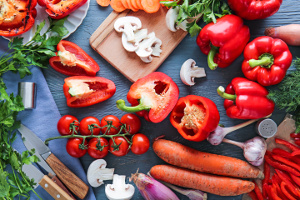Why is it healthier if you heat certain vegetables?
 Some people prefer to eat raw vegetables in combination with meat or fish or as entirely raw vegan diets. They believe it is healthier and delivers more energy. But the truth is that some vegetables are healthier and provide more antioxidants if you heat them. That’s the case with tomatoes, bell pepper, carrots, spinach, and mushrooms. And remember that raw mushrooms contain toxins that are broken down by cooking.
Some people prefer to eat raw vegetables in combination with meat or fish or as entirely raw vegan diets. They believe it is healthier and delivers more energy. But the truth is that some vegetables are healthier and provide more antioxidants if you heat them. That’s the case with tomatoes, bell pepper, carrots, spinach, and mushrooms. And remember that raw mushrooms contain toxins that are broken down by cooking.
Fruit and vegetables contain dietary fiber and a host of different vitamins, minerals, and secondary nutrients. Fiber is good for your digestion, while the other nutrients serve as antioxidants that can lower your risk of cardiovascular disease, diabetes, and cancer. According to the dietary guidelines, we should get 600 grams of fruit and vegetables daily, preferably 300 grams of each. Potatoes don’t count as vegetables.
It is commonly known that raw vegetables, fresh salads, and smoothies contain the most nutrients. Still, there are five items that actually become healthier if you heat them before eating them, and heating or cooking also makes them easier to digest.
Tomatoes
Many people like raw tomatoes in their salad. Tomatoes are healthy and contain nutrients such as vitamin C, beta-carotene (a precursor of vitamin A), folic acid, potassium, and phosphor. However, cooking or heating tomatoes makes them even healthier because it increases the release of lycopene, one of the most powerful antioxidants of all. Lycopene is highly effective when it comes to protecting our circulatory system, cells, and tissues against free radical damage.
Lycopene is linked to insulin sensitivity, heart health, and the prevention of various cancers. Lycopene is lipid-soluble. Therefore, the body absorbs and utilizes it better if you add some butter or olive oil to the cooked tomatoes.
Beta-carotene also belongs to the group of carotenoids that have powerful antioxidant properties. Cooking increases the bioavailability of beta-carotene by breaking down the cellular walls in the plant cells that contain beta-carotene.
Skinned tomatoes, tomato juice, tomato soup, and tomato ketchup (without sugar) are all good sources of cooked tomatoes with higher content of lycopene and beta-carotene. You can heat raw tomatoes in a pot or pan together with olive oil, garlic, and thyme. Ratatouille is a popular French dish that combines cooked tomatoes, bell pepper, squash, onions, and eggplant.
Bell pepper
Bell peppers contain more vitamin C than oranges and apples. They also provide beta-carotene, vitamin E, folic acid and other B vitamins, potassium, magnesium, molybdenum, and lycopene. Yellow and red bell peppers contain more vitamins, minerals, and antioxidants than green bell peppers. Cooking or heating bell peppers increases the level and utilization of lycopene and beta-carotene. It is advisable to heat or cook the gently to avoid excessive loss of vitamin C. Bell peppers taste great in stews, wok dishes, blended soups, or ratatouille. Add some sort of healthy fat to increase the uptake and utilization of lycopene.
- Carotenoids that give certain foods their yellow, orange, and red color are antioxidants
- Beta-carotene is found in e.g., carrots, tomato, rosehip, and spinach
- Lycopene, which is the most potent antioxidant, is found in tomatoes, red bell peppers, and rosehips
- Cooking or heating increases the release and uptake of lycopene and beta-carotene
- The absorption of lycopene from food is increased if you add healthy fats
Carrots
Carrots contain quite a lot of beta-carotene plus vitamin K, folic acid, vitamin C, potassium, and calcium. The high beta-carotene content is believed to be good for eye health. Cooking and heating will make beta-carotene more bioavailable.
Make your carrots “al dente” by steaming or cooking them. You can also use carrots in stews, wok dishes, soups, or you can glaze them with honey and bake them in the oven.
- Steamed vegetables tend to hold on to nutrients better than if you cook of fry them
Spinach
Spinach is called a super food because it contains a long list of nutrients like vitamin C, beta-carotene, vitamin K, potassium, iron, and lycopene. Spinach is green due to its high chlorophyll content. Spinach tastes great in a salad or smoothie. The utilization of nutrients like beta-carotene, lycopene, and iron is increased if you cook or heat spinach. Spinach is great in an omelet or sautéed with some butter and graded nutmeg. Fats increase the utilization of lycopene. Spinach also tastes good in pies like the Greek spanakopita pie or in stews.
Mushrooms
Raw mushrooms taste great in salads but we should try to avoid them because the contain different toxins. For example, raw mushrooms contain agaritine and phenylhydrazine, and shitake mushrooms contain lentinan. The body is unable to digest raw mushrooms. From a nutritional point of view, it makes no sense to eat them raw. On the contrary.
Cooked mushrooms, on the other hand, provide an abundance of nutrients like protein, folic acid and other B vitamins, potassium, selenium, and choline. Mushrooms taste great if you fry them in some butter or bake them in the oven with a little parsley butter in the middle.
References:
SciTechDaily. Health. Five Foods That Are better for You When Cooked. May 08, 2022
Wang Jia Qi et al. Investigating into anti-cancer potential of lycopene. Molecular Targets. Biomedicine & Pharmacotherapy 2021
Zhaohui Zeng et al. Lycopene Improves Insulin Sensitivity through Inhibition of STAT3/SREBP-1c-Mediated Lipid Accumulation and Inflammation in Mice fed a High-Fat Diet. Clin Endocrinol Diabetes 2017
Spis flere grøntsager og frugter - Alt om kost
Frida - Database med fødevaredata udgivet DTU Fødevareinstituttet (fooddata.dk)
Search for more information...
- Created on .








